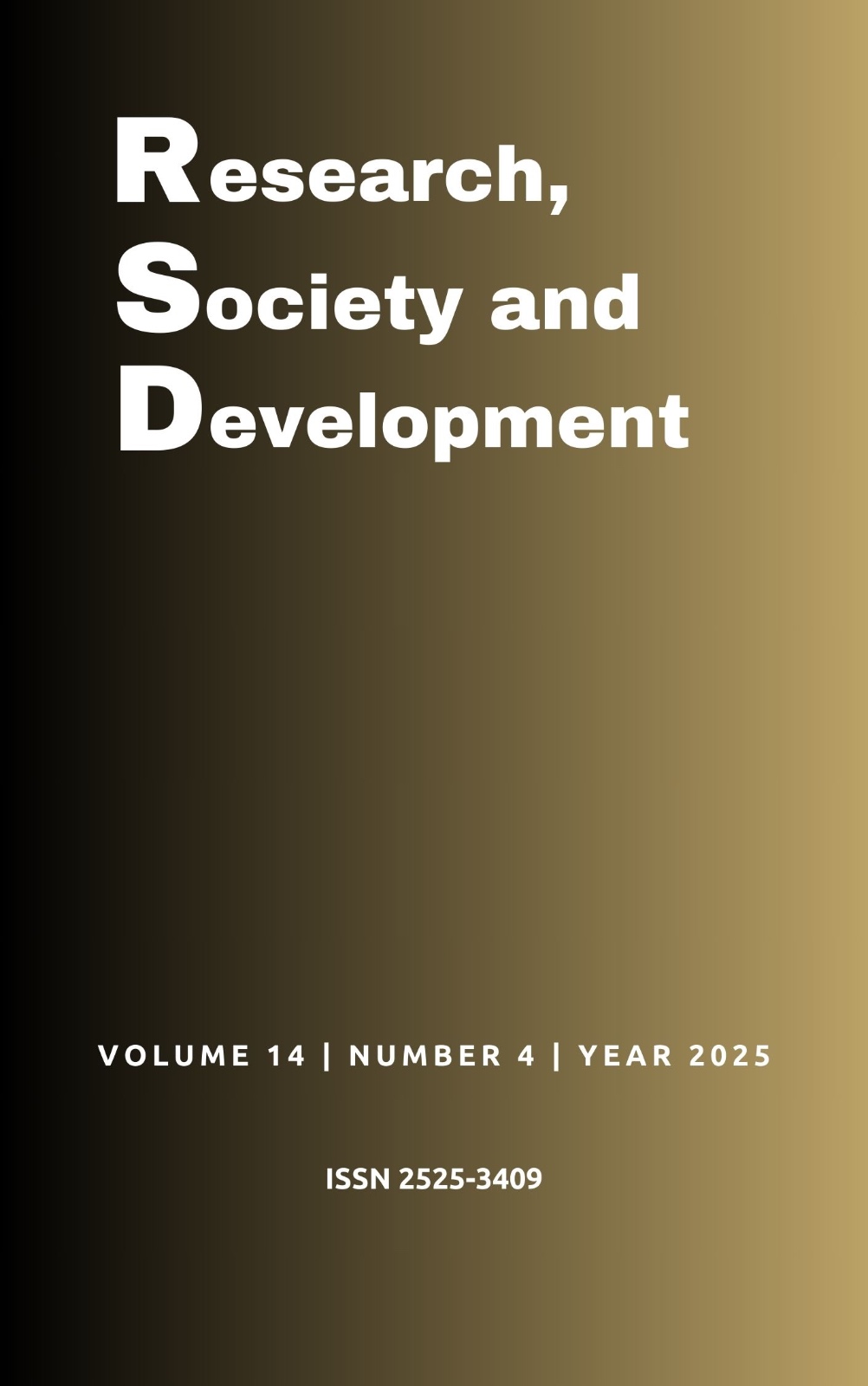Vertical increase of atrophic maxillary alveolar rim: A bibliographical review
DOI:
https://doi.org/10.33448/rsd-v14i4.48606Keywords:
Dental Implant, Vertical Bone Augmentation, Integrated Bone Implant, Alveolar Ridge.Abstract
Objective: The present literature review aimed to evaluate the different surgical techniques for vertical ridge augmentation in relation to the predictability of bone gain, the risk of complications, the success or failure rate of installed implants, as well as their survival rate. Methods: A narrative literature review was conducted, of a qualitative nature, with little systematization, in which data collection was carried out in the Scientific Electronic Library Online (SciELO) and the National Library of Medicine (PubMed) databases. Results: After analyzing the articles included in the review, the results of the studies showed that there are countless techniques able to produce a significant gain in thickness and height of the alveolar edge in jaws. Conclusion: despite the evolution of countless surgical techniques, the predictability of the vertical increase of the alveolar edge remains a challenge.
References
Albrektsson, T., Zarb, G., Worthington, P. & Eriksson, A. R. (1986). The long-term efficacy of currently used dental implants: a review and proposed criteria of success. Int J Oral Maxillofac Implants. 1(1), 11-25.
Bianchi, A., Felice, P., Lizio, G. & Marchetti, C. (2008). Alveolar distraction osteogenesis versus inlay bone grafting in posterior mandibular atrophy: a prospective study. Oral Surg Oral Med Oral Pathol Oral Radiol Endod. 105, 282-92.
Chiapasco, M., Romeo, E., Casentini, P. & Rimondini, L. (2004). Alveolar distraction osteogenesis vs. vertical guided bone regeneration for the correction of vertically deficient edentulous ridges: a 1-3-year prospective study on humans. Clin Oral Implants Res. 15(1), 82-95.
Chiapasco, M., Zaniboni, M. & Rimondini, L. (2007). Autogenous onlay bone grafts vs. alveolar distraction osteogenesis for the correction of vertically deficient edentulous ridges: a 2-4-year prospective study on humans. Clin Oral Implants Res. 18(4), 432-40.
Dennilson, D. K., Vallone, D. R., Pinnero, G. J., RittmanI, B. & Caffesse, R. G. (1994). Differential effect of TGF-beta 1 and PDGF on proliferation of periodontal ligament cells and gingival fibroblasts.J Periodontol. 65(7), 641–8.
Esposito, M., Grusovin, M. G., Felice, P., Karatzopoulos, G., Worthington, H. V. & Coulthard, P. (2009). Interventions for replacing missing teeth: horizontal and vertical bone augmentation techniques for dental implant treatment. Cochrane Database Syst Rev. 7(4), CD003607.
Fontana, F., Santoro, F., Maiorana, C., Iezzi, G., Piattelli, A. & Simion, M. (2008). Clinical and histologic evaluation of allogeneic bone matrix versus autogenous bone chips associated with titanium-reinforced e-PTFE membrane for vertical ridge augmentation: a prospective pilot study. Int J Oral Maxillofac Implants. 23(6), 1003-12.
Huh, J. B., Park, C. K., Kim, S. E., Shim, K. M., Choi, K. H., Kim, S. J., Shim, J. S. & Shin, S. W. (2011). Alveolar ridge augmentation using anodized implants coated with Escherichia coli-derived recombinant human bone morphogenetic protein 2. Oral Surg Oral Med Oral Pathol Oral Radiol Endod. 112(1), 42-9.
Kämmerer, P. W., Palarie, V., Schiegnitz, E., Nacu, V., Draenert, F. G. & Al-Nawas, B. (2012). Influence of a collagen membrane and recombinant platelet-derived growth factor on vertical bone augmentation in implant-fixed deproteinized bovine bone – animal pilot study. Clin Oral Implants Res. 4, 1-9.
Liu, Y., Huse, R. O., de Groot, K., Buser, D. & Hunziker, E. B. (2007). Delivery mode and efficacy of bmp-2 in association with implants. J Dent Res. 86, 84–9.
Pereira A. S. et al. (2018). Metodologia da pesquisa científica. [e-book]. Editora UAB/NTE/UFSM. https://repositorio.ufsm.br/bitstream/handle/1/15824/Lic_Computacao_Metodologia-Pesquisa-Cientifica.pdf?sequence=1.
Polo, C. I., Oliveira Lima, J. L., De Lucca, L., Piacezzi, C. B., Naclério-Homem, M. D., Arana-Chavez, V. E. & Sendyk, W. R. (2013). Effect of Recombinant Human Bone Morphogenetic Protein 2 Associated with a Variety of Bone Substitutes on Vertical Guided Bone Regeneration in Rabbit Calvarium. J Periodontol. 84(3), 360-70. doi: 10.1902/jop.2012.110674. https://pubmed.ncbi.nlm.nih.gov/22524330/.
Rocchietta, I., Fontana, F. & Simion, M. (2008). Clinical outcomes of vertical bone augmentation to enable dental implant placement: a systematic review. J Clin Periodontol. 35(8 Suppl), 203-15.
Roccuzzo, M., Ramieri, G., Bunino, M. & Berrone, S. (2007). Autogenous bone graft alone or associated with titanium mesh for vertical alveolar ridge augmentation: a controlled clinical trial. Clin Oral Implants Res. 18(3), 286-94.
Hollinger, J. O., Hart, C. E. & Hirsch, S. N. (2008). Recombinant human plateletderived growth factor: biology and clinical applications. J Bone Joint SurgAm. 90(suppl 1), 48–54.
Scarano, A., Assenza, B., Di Cerbo, A., Candotto, V., Santos De Oliveira, P. & Lorusso, F. (2017). Bone regeneration in aesthetic areas using titanium micromesh. Three case reports. Oral Implantol (Rome). 10(4), 488-94.
Seibert, J. S. (1983). Reconstruction of deformed, partially edentulous ridges, using full thickness onlay grafts. Part II. Prosthetic/periodontal interrelationships. Compend Contin Educ Dent. 4(6), 549-62.
Downloads
Published
Issue
Section
License
Copyright (c) 2025 Daniel Falleiro Simundi; Laiza Naiara Schmitz Simundi

This work is licensed under a Creative Commons Attribution 4.0 International License.
Authors who publish with this journal agree to the following terms:
1) Authors retain copyright and grant the journal right of first publication with the work simultaneously licensed under a Creative Commons Attribution License that allows others to share the work with an acknowledgement of the work's authorship and initial publication in this journal.
2) Authors are able to enter into separate, additional contractual arrangements for the non-exclusive distribution of the journal's published version of the work (e.g., post it to an institutional repository or publish it in a book), with an acknowledgement of its initial publication in this journal.
3) Authors are permitted and encouraged to post their work online (e.g., in institutional repositories or on their website) prior to and during the submission process, as it can lead to productive exchanges, as well as earlier and greater citation of published work.


